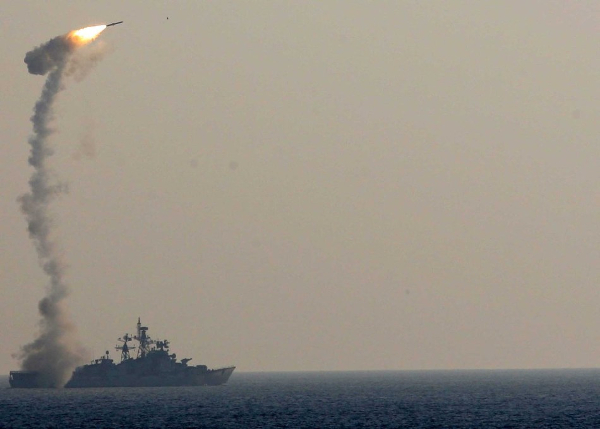The Indian Navy announced on Friday that it had achieved a “significant milestone” in its anti-air warfare capabilities by having one of its warships control missiles fired from two ships.
The Indian Navy announced that, with the test of this cooperative engagement system, “it has become a part of a select group of navies that have this niche capability. This capability significantly enhances the combat effectiveness of the Indian Navy, thereby providing an operational edge over potential adversaries.”
A press release by the Indian Navy described the test as its “maiden cooperative engagement”, for which the Medium-Range Surface-to-Air Missile (MRSAM), co-developed with Israel, was used. Israel Aerospace Industries refers to the MRSAM as the Barak-8 missile. The Indian Navy statement said the test was “carried out by the Indian Navy, DRDO and Israel Aerospace Industries”.
The test was conducted on the Western Seaboard and involved the warships, INS Kochi and INS Chennai. Both INS Kochi and INS Chennai fired their MRSAM missiles, which were controlled by one of the ships to “intercept different aerial targets at extended ranges”.
Both the INS Kochi and INS Chennai are ships of the Kolkata class of destroyers and are equipped with the Israeli-origin ELM-2248 MF-STAR radar system and MRSAM missiles. According to an Israel Aerospace Industries brochure, the MF-STAR radar can track a large number of targets over 450km away.
Cooperative engagement involves using data-links between ships and platforms to have a “common picture” of a battle situation and taking control of weaponry on multiple platforms. A cooperative engagement system allows navies to respond more rapidly to ‘saturation attacks’ involving large numbers of low-flying anti-ship missiles. Cooperative engagement revolves around maximising the advantages offered by sophisticated radars such as the MF-STAR.
The US Navy has developed a Cooperative Engagement Capability (CEC) for decades, which it describes as a “real-time sensor netting system that enables high-quality situational awareness and integrated fire control capability.” The US Navy explains CEC involves the “netting of geographically dispersed sensors to provide a single integrated air picture, thus enabling integrated fire control to destroy increasingly capable threat cruise missiles and aircraft.”
In addition to data from warships, the US Navy’s CEC also collates information from aircraft, satellites and other sensors. The US Navy, the Royal Australian Navy and Japanese Maritime Self-Defense Force are navies that are known to have adopted the CEC. These navies use the US-developed Aegis battle management system and Standard Missile series of missiles. The US Navy has also tested CEC for use in ballistic missile defence roles.
Source: TW
Image Courtesy: Global Military Review
You may also like
-
IAF Aircraft Set Course For Exercise Eastern Bridge VII At Oman
-
IAF Set To Host The Indian Defence Aviation Exposition-II At Jodhpur
-
Defence Secretary to co-chair 5th India-Philippines Joint Defence Cooperation Committee meeting in Manila
-
Simultaneous Launch Of ‘malpe And Mulki’, Fourth And Fifth Ships Of Asw Swc (Csl) Project
-
Aatmanirbharta in Defence: MoD signs Contract with HAL for 240 AL-31FP Aero Engines for Su-30MKI Aircraft
